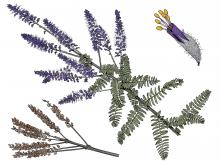Trees, Shrubs and Woody Vines
Media

Species Types
Scientific Name
Rhus spp.
Description
Sumacs are shrubs or small trees that often form colonies from their creeping, branched roots. The foliage usually turns brilliant shades of red in early autumn. The clusters of berrylike fruits are red.
Media

Species Types
Scientific Name
Toxicodendron radicans
Description
Poison ivy is a toxic plant that contains an oil in all its parts that, if you come into contact with it, can cause an intense skin reaction. Learn to recognize it, and sidestep it on your outings.
Media

Species Types
Scientific Name
Nandina domestica
Description
Heavenly bamboo is hardly “heavenly” when it comes to its negative effects on our native plants and animals. A tremendously popular landscaping plant, it readily escapes and is difficult to eradicate.
Media

Species Types
Scientific Name
Sambucus canadensis
Description
Common elderberry is a colony-forming shrub with opposite compound leaves. Its large, flattened clusters of small white flowers produce purple or black berrylike fruits.
Media

Species Types
Scientific Name
Amorpha canescens
Description
Lead plant is a densely hairy small shrub producing tight, elongated spikes of small purple flowers from May through August. It grows in prairies, glades, and savannas.
Media

Species Types
Scientific Name
Zanthoxylum americanum
Description
Common prickly ash is a thicket-forming shrub or small tree. Its compound leaves resemble of those of ash trees, but it’s in a different family. Pairs of stout, curved prickles occur at each node. Scattered statewide, but less common in the Ozarks.
See Also
About Trees, Shrubs and Woody Vines in Missouri
There are no sharp dividing lines between trees, shrubs, and woody vines, or even between woody and nonwoody plants. “Wood” is a type of tissue made of cellulose and lignin that many plants develop as they mature — whether they are “woody” or not. Trees are woody plants over 13 feet tall with a single trunk. Shrubs are less than 13 feet tall, with multiple stems. Vines require support or else sprawl over the ground.





















